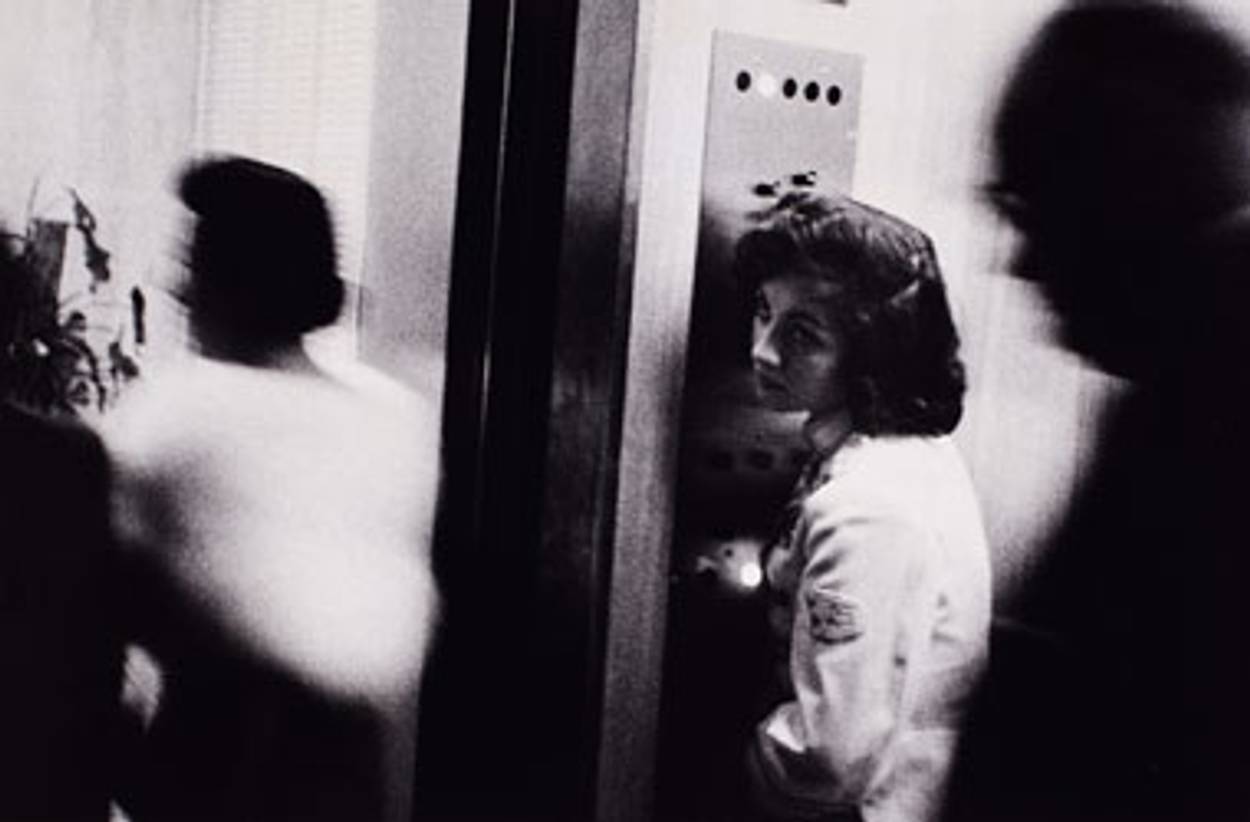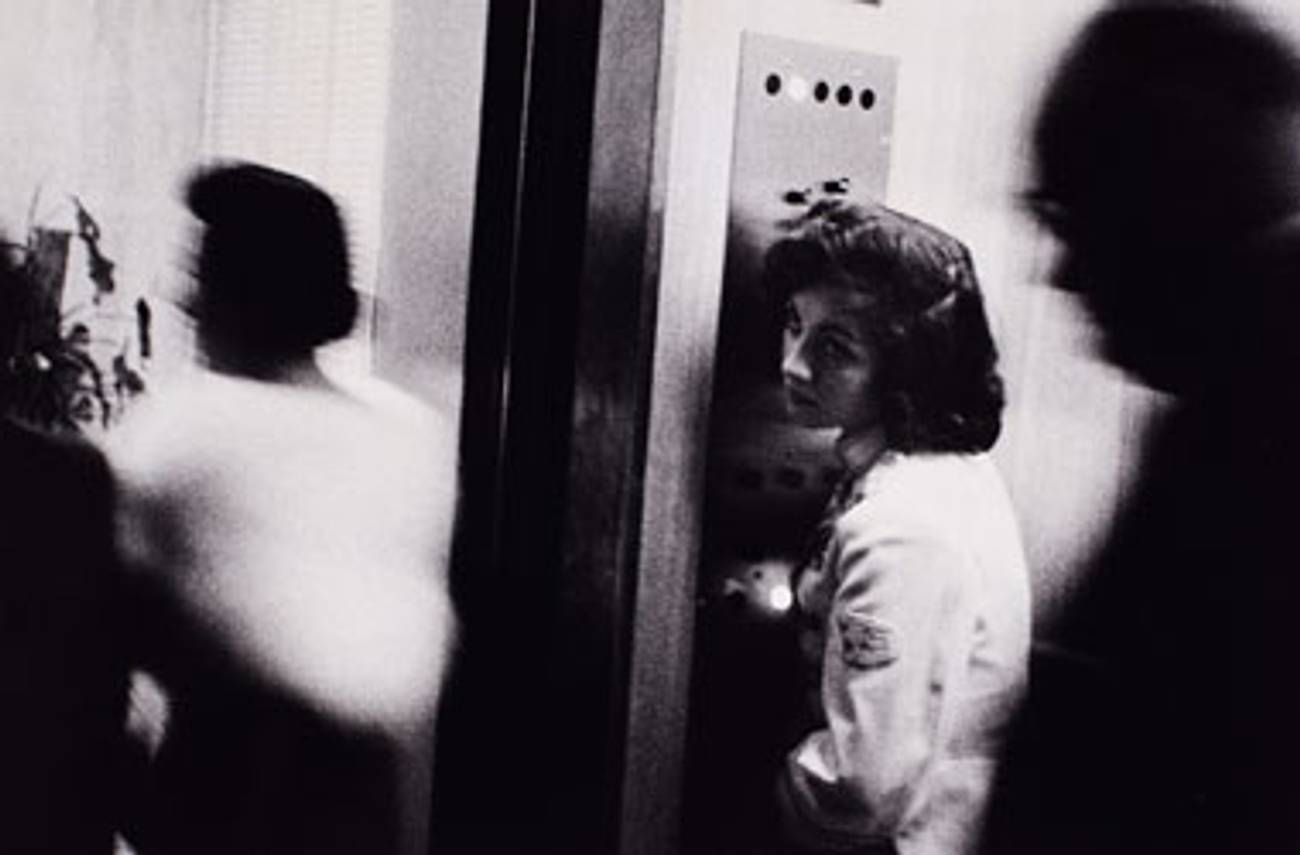Clique
Did Jewishness inform Robert Frank’s photographic vision?




On November 7, 1955, the Swiss photographer Robert Frank was arrested in McGehee, Ark. The police, hoping to ferret out a real live Communist, questioned him for four hours because, as they subsequently explained, he was foreign; he was Jewish; his car was “heavily loaded with suitcases, trunks and a number of cameras;” he had “foreign whiskey,” a “foreign box” of candy, and had given his kids “foreign names.”
If the cops were after political liberals, they had the right man. But Frank was an aesthetic subversive, not a Marxist one. At the time of his arrest, he was traveling around the United States on a Guggenheim fellowship, taking pictures for what he described as “a spontaneous record of a man seeing this country for the first time.”
The result of this trip, Frank’s book The Americans, is fifty years old this year and an exhibition that will travel from Washington to San Francisco and then to New York marks its birthday. The show is impressive in its size and its range. While it focuses on The Americans, it provides an overview of the man’s career, no small task when dealing with an artist with his talent for constant restlessness.
Frank, who was born in Zurich in 1924, is also a very prolific photographer. For The Americans, he took over 700 rolls of film during his somewhat haphazard journey across American and culled 83 to create his book. That ratio, daunting as it is, serves as a leading indicator of Frank’s perfectionism. Though Frank was already recognized as a major talent by the time he was 31, The Americans is not a model of technical mastery, especially not the kind that people had come to expect of documentary photography by the mid-1950s. The pictures are often out of focus. Some of them are very grainy. Some of them are tilted or get the lighting wrong. But the photographs were striking enough to make history. Frank has been the most influential photographer the last half-century.
The exhibition’s curator, Sarah Greenough, points out that in spite of Frank’s talent, he had a hard time getting published in American magazines because editors felt that his photographs were too personal. That strong, subjective vision marks The Americans and helps account for the willed and willful technical “mistakes” in Frank’s work. Take for instance the photograph of a jukebox in a New York bar. The highlights in the mirrors are just too bright (especially in comparison to the murkiness of the bar itself) and a shadowy arm cuts across the jukebox itself. Those highlights and that arm are precisely the point, however. A number of his photographs (such as the one of an elevator operator in Florida) are about speed and the remarkable ability of people who are rushing not to notice things. The uncanny light that shines from the jukebox seems to transfigure the machine and because of the perspective, that dark arm seems, quite literally, to brush past it. Unlike the man, the camera sees and so, you have to suppose, do we.
In The Americans, Frank shows a remarkable empathy for forlorn or forgotten things: for merchandise not yet bought, for empty gas stations, and for buildings at night. He also reveals a similar empathy for those who used to be called, however quaintly, the underprivileged. They include autoworkers, Latino transvestites, and especially (remember—this was the 1950s) blacks.
Frank is less forgiving when it comes to self-satisfied white folks. Some of his targets are a little too easy: rich women in furs in the lobbies of hotels or at garden parties, politicians on the hustings or at conventions, even confident looking cowboys in bars. White workers do not suffer this treatment, however, as in the case of the bored elevator operator, who is ignored by the blurs pushing past her.
It’s hardly surprising then that the book’s first critics found it harsh. Some were convinced that it was un-American. To be sure, the book must have been unsettling then and it retains some of that quality although we might now be too comfortable with its view of consumerism and race relations.
The weary, existentialist alienation that pervades it might be as historical as the world it depicts, a world of drive-ins, cars with fins, and pictures of Ike. Frank was a European. He allied himself with the New York avant-garde of his time. He had a number of friends amongst the Abstract Expressionists and was very close to Allen Ginsberg and the Beat writers. He shared their collective distaste for the man in the gray flannel suit and the industrial flattening-out of individual creativity.
Several factors save The Americans from becoming a mere historical artifact. The first, and most basic, is that the book displays neither the Abstract Expressionists’ self-mythologizing heroism nor the Beats’ stoned and goofy sense of prophetic vision. The contrast between Frank and Ginsberg and Kerouac (who wrote the introduction to The Americans) is most visible in the movie Pull My Daisy, which Kerouac wrote and Frank co-directed. In the film, Ginsberg, the poets Peter Orlofsky and Gregory Corso, the composer David Amram, and the painter Larry Rivers cavort, spout pleasant nonsense, riff on religious themes, and play some impressive post-bebop jazz. Interestingly enough, the film only looks like one of Frank’s photographs when the narration is silent or when the camera pans past inanimate objects. The Americans might critique America, but it has none of the Beats’ manic noise. Like the Beats, it is fascinated by speed. Unlike them, it is remarkably silent.
More important though, the structure of The Americans sets up a dialog between the photos that might not be properly cinematic, but it is, as Greenough points out in her catalog, strongly rhythmic. It does not display the pictures on facing pages. Rather, each one is separated from the next by a blank page. This layout forces you to concentrate on individual photos, but also leads you to try to connect them. The relations that bind them are rarely narrative or chronological. Sometimes the connection between them is thematic, sometimes visual. More often than not it is both, a complex play of contrasts and continuities. The Americans is first and foremost a book, and the photographs risk losing some of their resonance when they are taken out of their fluid contexts.
In spite of their risks and their looseness, the pictures in The Americans display an important compositional consistency. Unlike many famous photographers, Frank does not hew to the horizontal axis. He tilts the horizon or skews it. More often than not, he organizes his shots around a vertical line or object near the center of the image. These verticals lead the photographs away from the landscape tradition—which is all about horizons—into an adamantly man-made world.
The photographer William Klein has said that if you look at modern photography, you find “on the one hand, the Weegees, the Diane Arbuses, the Robert Franks, funky photographers. And you then you have the photographers who go out to the woods.” According to Klein’s distinction, the Jews are funky and the goyim are not. It might just come down to the distinction between the city and the country, though that doesn’t really do justice to Klein’s insight or to the great street photographer Garry Winogrand’s boast that in order to be a great photographer you have to be Jewish. Indeed quite a few of the great American photographers have been Jewish. The question—isn’t this always the question?—is why.
Given the difference in their religious backgrounds, we can’t boil the importance of Jews in American photography down to shared beliefs except in the most abstract of ways. (Are Jews more interested in social justice? Yes, of course. And so are others.) My guess is that Jews’ prominence in the field has more to do with sociology than theology. The “funkier” Jewish photographers that Klein mentions (including Winogrand and Klein himself) are all city kids—photographers from urban backgrounds who end up shooting what they know and what they’ve seen. But that is too simple: Jews have also been of necessity attracted to precisely those fields where there were few if any restrictions. Make money in the rag trade? Invent Hollywood. Can’t get into advertising? Invent comic books. Want to be a composer? Write popular songs. Want to do art? Become a photographer.
But the answer is probably still more complicated. If Jews make up the ranks of the “funky” photographers, it might have something to do with their place in the avant-garde. Perhaps their outsider status as Jews has granted these photographers the requisite distance from the mainstream. If this is the case, Jewish difference—whether proudly embraced or merely imposed—plays itself out as a clear aesthetic difference.
All of these answers are probably right but they are also probably insufficient. Nevertheless, as far as it goes, Frank fits the bill. A Jew from a country with a tiny Jewish population, a native of a major city, a political progressive with a double or triple alienation from the United States, Frank is by force a “funky” photographer. The most salient aspect of Frank’s achievement however is that The Americans has remained so fresh.
The Americans opened up a host of new possibilities for photography. It allowed people to make really interesting “mistakes.” For five decades now photographers have been working out the implications of The Americans, of its themes, compositions, lighting and affect. You can find its traces everywhere, in wildly different artists like Stephen Shore and Nan Goldin. In the face of that resonance, in the face of the sheer strength of Frank’s work, the precise nature of its Yiddishkeit fades—almost literally—into the background.
David Kaufmann teaches literature at George Mason University.
Elevator—Miami Beach, 1955: courtesy of Philadelphia Museum of Art, purchased with funds contributed by Dorothy Norman, 1969. Photograph © Robert Frank, from The Americans.
Charleston, South Carolina, 1955 and Funeral—St. Helena, South Carolina, 1955: courtesy of Susan and Peter MacGill. Photograph © Robert Frank, from The Americans.
David Kaufmann teaches literature at George Mason University.